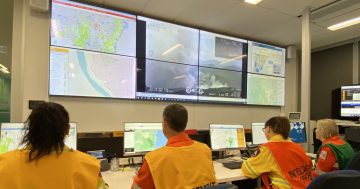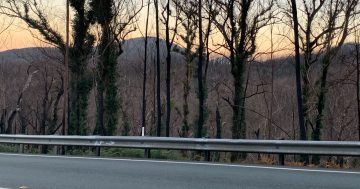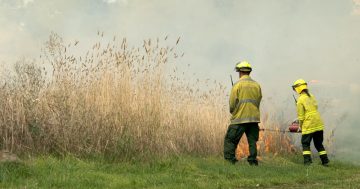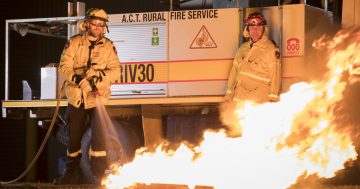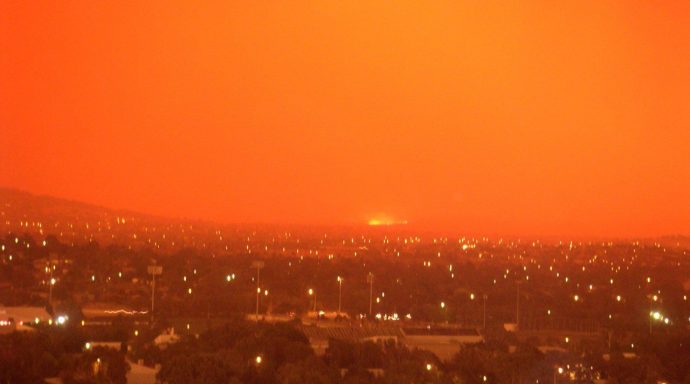
ACT firefighters explain why this is another high-risk year for bushfires, like 2003. File photo.
Critical deep soil dryness and the reality of climate change mean that Canberra is facing “a pretty ordinary” high-risk fire season. Complacency, and our willingness to build in areas that are vulnerable to unpredictable wildfire behaviour also complicates efforts to prevent destructive blazes, according to frontline firefighters and fire researchers.
ACT Rural Fire Service chief officer Joe Murphy says that there’s a lot of science in making short and longterm fire risk calculations with the Bureau of Meteorology, which are listed on the ESA website.
“One of the key things is the drought factor, including the fine fuel dryness for grasses and pine needles and small twigs that react very rapidly to changes in humidity. From that, we calculate a forest fire index and a grass fire index, which are quite different in terms of terrains and fuels.”
One of the key drivers this year is extreme soil dryness. Joe Murphy believes few people realise how critical this is, even when grass fuel loads are relatively low as they are now.
“Let me give you an example,” he says. “We had about 25mls of rain on the Pierce’s Creek fire last week and the immediate aftermath the drought factor dropped down to about two on a scale of ten. That’s fantastic, but because the ground is so dry deep down, within three days it was back to eight or nine. The return to elevated drought factor now happens very rapidly.
“Big fuels take a long time to get going and they put a huge amount of energy into the fire. But fine fuels run ahead of the fire, and that’s where the ember attack comes from. People see green grass and they think we’re OK, but there’s been no deep soaking rain since 2016.”
Joe Murphy wants to put clearly on the record that he believes in climate change and that it’s a major problem for Canberra’s fire risk. “It’s the new normal to see extended fire seasons. The 2003 fires here came out of six or seven years of drought. In 2009, Black Saturday was the result of extended drought in Victoria. There is just no humidity in the central NSW/ACT region.”
While there’s not much grass, fuel loads have been steadily increasing in the hills and prescribed burning is underway on a regular basis to target high-risk areas. But Joe Murphy says that it would take a week of steady, soaking rain to alleviate the general risk for the ACT and surrounding areas.

The Pierce’s Creek fire should ring warning bells for unprepared Canberrans. Photo: Jack Mohr.
Associate Professor Jason Sharples is Project Leader for the Bushfire and Natural Hazards CRC’s ‘Spot Fire’ Project. He also worries about complacency around where we build our houses. “If you have really steep slopes that align with the wind, or leeward slopes interacting with wind over the top, then flame depth can grow very rapidly. In these situations, embers turn into mass spotting events and that leads to what we call deep flaming, where large areas are going up in a short amount of time.”
And, he says dryly, you’d be surprised how often a high-risk fire area and a place with lovely prospects for a house are the same in Canberra. “I think the main message is people tend to have very naive views of what a bad fire is going to look like. People think it moves across the landscape in a fairly orderly fashion. But on a bad day in risky terrain, fire arrives as an ember storm and you won’t see it coming.”
Joe Murphy urges people to check out the ESA website to discover if they’re in a high-risk bushfire area and to download and complete a bushfire survival plan “Not tomorrow, but today. People tend to be complacent. 2003 was 15 years ago, and a lot has changed in Canberra during that time.”
And he, says, talk to your neighbours. “If you’ve got vulnerable members in your local area, you have a responsibility to be part of community action. Understand who is around you, be connected and communicate.”
He urges people to understand how the roadside fire warnings work, pointing out that they aren’t a measure of the fire risk, but how hard it will be to control a fire. “If we can leverage any message from Pierces Creek, it would be that the people of Canberra need to be prepared. We’ll do our utmost best to prevent the worst day they’ll ever have, but everyone needs to be ready.”
Do you know what your fire risk really is?












